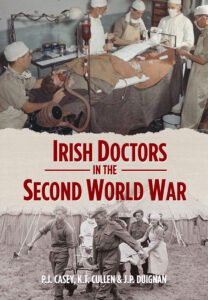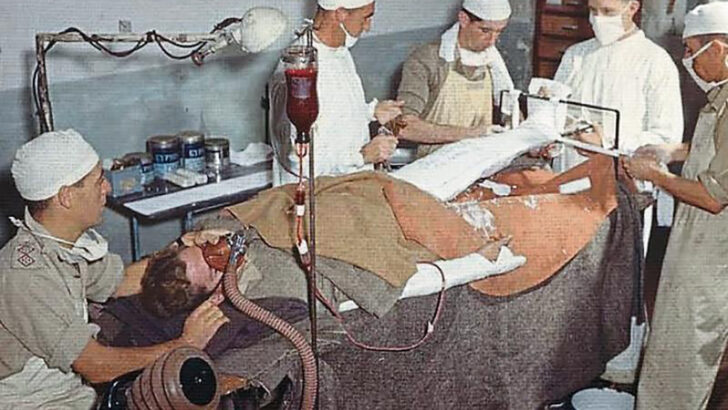Irish Doctors in the Second World War
by PJ Casey, KT Cullen, and JP Duignan (Merrion Press, €29.99/£25.99)

This is a comprehensive account of the Irish doctors who served with the Allied forces in World War II. This is for all intents and purposes an untold story, but one that needed to be told for what it reveals about what Irish people really did in that formative universal conflict.
There were 2,003 of them in all. 435 were trained in Queen’s University Belfast, 357 in Trinity College Dublin, 80 in the Royal College of Surgeons, 133 in University College Dublin, 83 in University College Cork, 30 in University College Galway and 42 elsewhere. These Irish doctors served in a number of British forces: the Royal Army Corps, the RAF, RN and VR (Voluntary Reserves). They were active in Europe and North Africa.
Of the doctors who died, 22 in the RAMC were killed and 18 died in service. Six were killed in action in the RAF and three died in service. 11 were killed in the RN and six died in service. Five died in other services. In all 79 lost their lives.
Irish
John Noel Corcoran, a native of Dún Laoghaire and a graduate of TCD, was the first to lose his life. He was killed in the earlier period of the war as the British Expeditionary Force retreated from central France back to Dunkirk.
Hundreds of Irish doctors were captured by the German and Japanese forces. Those held by the Germans were interned in POW camps across Central Germany and were treated in accordance with the appropriate protocols. But those held by the Japanese were cruelly treated. As a result, following the war, the administrators of those POW camps were convicted of war crimes, and either hanged or sentenced to a life-time in prison.
290 Irish doctors received medals and awards for service and/or valour. The authors provide the citations granted to some of them. Among them was Dr Frank Murray.
He was captured by the Japanese in Singapore on 15 February 1942.
Firstly, he was interned in Changi camp, one of the more notorious Japanese POW camps. Subsequently he was transferred to prison camps in Hokkaido, the Japanese mainland. His fellow-prisoners were over 400 service-men from the British Army, Air Force, Navy, Mercantile Marine and the US Army and they elected him to be commandant of the camp.
“It was managed by a drug addict and sadist who was convicted at the end of the war and executed for his treatment of Allied prisoners”
Subsequently they presented him with a Memorial which recorded his ‘quiet and indomitable struggle for our health and welfare in the face of obstructive and often vicious Japanese inhumanity’.
Dr Aidan McCarthy, of Castletownbere, Co Cork, was also captured by the Japanese. In 1941 he began his amazing prisoner of war odyssey in Java, in what was then the Dutch East Indies (now the Republic of Indonesia).
His first POW camp was in Batavia (now Jakarta) in a former Dutch army barracks. It was managed by a drug addict and sadist who was convicted at the end of the war and executed for his treatment of Allied prisoners.
In June 1944 the Japanese transferred their POWs to Japan itself. McCarthy found himself in Nagasaki, where he and his fellow-prisoners were forced to work in the shipyard until the end of the war. When the US dropped the atomic bomb on the city on 9 August 1945 he escaped death, as he was in an underground shelter. Most of his fellow-prisoners, however, who were over-ground were incinerated along with some 40,000 of the city’s population.
For years afterward, people continued to die from the long lingering effects of burns, radiation sickness, and other injuries, made worse by lack of food and rampant illness in both of the bombed cities. (The effect of the atom bombs was described by John Hershey in the now classic Hiroshima, a book that has never been out of print since 1946.)
Honours
The book includes an excellent summary of the progress of the war across Europe and Asia. There is a list of medals and awards which were presented for service and gallantry in action.
Besides a roll of honour of those who served in World War II, there are profiles of thirteen Irish doctors who were honoured for their gallantry and professionalism.
The book is meticulously illustrated. This publication will be warmly welcomed particularly by the entire Irish medical community and will be cherished by the relatives and friends of those gallant and persevering Irish doctors who joined what became, in effect, a crusade to defend Western democracy.


 An Irish medical unit at work on a wounded casualty of WWII. Care and healing in a time of
war.
An Irish medical unit at work on a wounded casualty of WWII. Care and healing in a time of
war.